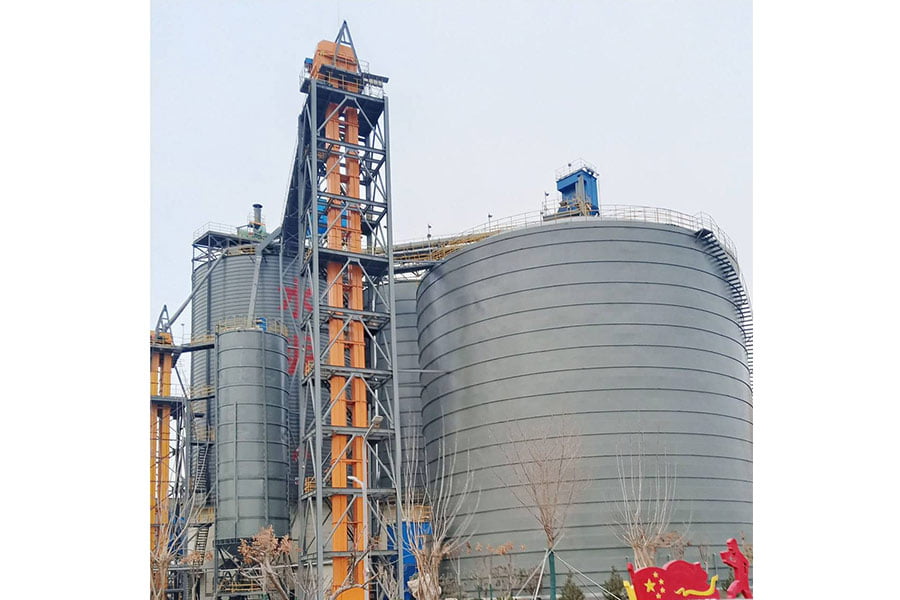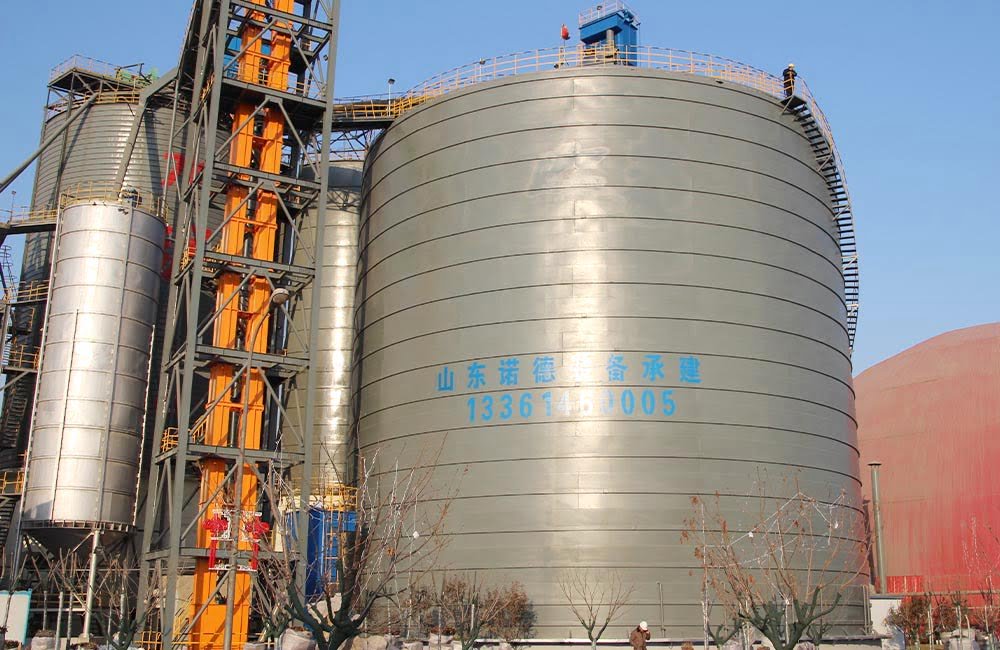مقدمة

In the realm of construction, eco-friendly design principles are gaining traction as the industry seeks sustainable solutions. This blog post explores the numerous benefits of adopting eco-friendly design for cement silo structures. From reducing environmental impact to enhancing operational efficiency, eco-friendly design practices offer a host of advantages that resonate with the modern construction ethos.
الحد من الأثر البيئي
Eco-friendly design for cement silos represents a commitment to sustainability, aiming to minimize environmental impact throughout the construction process and beyond. This holistic approach encompasses various strategies and features that collectively contribute to reducing the carbon footprint and conserving natural resources.
One key aspect of eco-friendly design is the use of energy-efficient materials. By selecting materials with high thermal performance and low embodied energy, such as recycled concrete aggregates or insulated panels, construction projects can significantly reduce energy consumption during manufacturing and installation phases. Additionally, these materials enhance the thermal efficiency of the silo structure, reducing heating and cooling demands and further lowering energy usage over the lifespan of the facility.
Renewable energy integration is another crucial component of eco-friendly design for cement silos. Incorporating renewable energy sources such as solar panels or wind turbines into the design allows the facility to generate clean, sustainable power on-site. This not only reduces reliance on fossil fuels but also helps offset carbon emissions associated with energy consumption, contributing to overall environmental sustainability.
Waste reduction strategies play a vital role in eco-friendly design, minimizing the amount of waste generated during construction and operation. This can include implementing recycling programs, utilizing prefabricated components to minimize onsite waste, and adopting construction techniques that maximize material efficiency. By reducing waste sent to landfills and promoting resource conservation, these strategies help preserve natural resources and minimize environmental degradation.
Energy Efficiency and Cost Savings
Efficient resource utilization stands as a cornerstone of eco-friendly design for cement silos, epitomizing a commitment to sustainability and responsible stewardship of resources. Within this context, the incorporation of energy-efficient design elements plays a pivotal role in minimizing environmental impact and fostering long-term cost savings through reduced energy consumption.
Insulation represents a fundamental aspect of energy-efficient design for cement silos. By incorporating high-performance insulation materials into the structure, such as foam panels or reflective coatings, thermal losses can be minimized, ensuring optimal temperature regulation within the silo. This not only enhances the durability of stored materials but also reduces the need for heating or cooling systems, resulting in significant energy savings over time.
Passive solar techniques offer another avenue for enhancing energy efficiency in cement silo design. By strategically positioning windows, skylights, or light shelves to maximize natural daylighting, reliance on artificial lighting can be reduced, thereby lowering energy consumption associated with lighting systems. Additionally, passive solar design principles, such as thermal mass and solar orientation, can help regulate indoor temperatures, reducing the need for mechanical heating or cooling systems and further decreasing energy usage.
Improved Air Quality and Health Benefits
Eco-friendly design practices extend beyond environmental sustainability to encompass the promotion of better indoor air quality and the enhancement of occupant health and well-being. Within the context of cement silo designs, these practices play a pivotal role in creating healthier work environments for construction workers and surrounding communities by minimizing emissions and pollutants.
One key aspect of eco-friendly design is the selection of low-emission materials and construction techniques. By choosing materials with low volatile organic compound (VOC) emissions and minimizing the use of harmful chemicals, eco-friendly cement silo designs help prevent the release of pollutants into the indoor environment. This reduces the risk of indoor air pollution, which can have detrimental effects on respiratory health and overall well-being.
Additionally, eco-friendly design practices prioritize adequate ventilation and air circulation within cement silo structures. Proper ventilation systems ensure the continuous exchange of indoor and outdoor air, removing pollutants and maintaining optimal indoor air quality. This not only enhances the comfort and productivity of construction workers but also minimizes the concentration of airborne contaminants, mitigating the risk of respiratory issues and allergies.
Enhanced Durability and Longevity

Sustainable design principles not only prioritize environmental responsibility but also contribute to the longevity and durability of cement silo structures. By incorporating eco-friendly materials, corrosion-resistant coatings, and innovative construction techniques, sustainable design extends the lifespan of cement silos, reducing the need for frequent maintenance and replacement.
One key aspect of sustainable design is the use of eco-friendly materials that are durable and resistant to environmental degradation. For example, incorporating recycled aggregates or fly ash into concrete mixes reduces the demand for virgin materials and enhances the strength and durability of the structure. Additionally, sustainable design practices prioritize the use of materials with low embodied energy and minimal environmental impact throughout the construction process, further contributing to the longevity of the silo.
Corrosion-resistant coatings play a crucial role in protecting cement silo structures from deterioration caused by exposure to harsh environmental conditions. By applying protective coatings such as epoxy or zinc-rich paints, the surface of the silo is shielded from corrosion, rust, and chemical damage, thereby extending its lifespan and reducing the need for costly repairs or replacements. These coatings provide an additional layer of defense against moisture, UV radiation, and corrosive substances, ensuring the structural integrity of the silo over time.
Regulatory Compliance and Stakeholder Satisfaction
Adopting eco-friendly design for cement silos aligns with regulatory requirements and stakeholder expectations for sustainable construction practices. By demonstrating commitment to environmental stewardship, construction firms can enhance their reputation, attract environmentally conscious clients, and gain a competitive edge in the market.
| Benefits of Adopting Eco-Friendly Design for Cement Silos | وصف |
|---|---|
| الامتثال التنظيمي | Aligning with regulatory requirements for sustainable construction practices ensures adherence to environmental standards and minimizes the risk of fines or penalties. |
| Enhanced Reputation | Demonstrating commitment to environmental stewardship enhances the reputation of construction firms, positioning them as leaders in sustainability and responsible business practices. |
| Attraction of Environmentally Conscious Clients | Eco-friendly design appeals to environmentally conscious clients who prioritize sustainability, providing construction firms with a competitive advantage in securing projects. |
| Competitive Edge in the Market | By embracing eco-friendly design, construction firms differentiate themselves from competitors, attracting clients who value sustainability and offering unique selling propositions. |
خاتمة
In conclusion, the benefits of eco-friendly design for cement silo structures are far-reaching and multifaceted. By prioritizing sustainability, construction firms can reduce environmental impact, lower operational costs, improve occupant health, enhance structural durability, and achieve regulatory compliance. Embracing eco-friendly design practices not only aligns with the industry’s sustainability goals but also positions businesses for long-term success and resilience in a rapidly evolving construction landscape.
التعليمات
Q: Are eco-friendly materials more expensive for cement silo construction?
A: While initial costs for eco-friendly materials may be slightly higher, the long-term benefits in terms of energy savings, durability, and environmental impact reduction often outweigh the upfront expenses.
Q: How can I ensure that my cement silo design is eco-friendly?
A: Incorporating eco-friendly design principles involves factors such as material selection, energy efficiency measures, waste reduction strategies, and consideration of environmental impact throughout the design process. Consulting with architects, engineers, and sustainability experts can help ensure that your cement silo design aligns with eco-friendly principles.
Q: What are some examples of eco-friendly features in cement silo design?
A: Eco-friendly features in cement silo design may include the use of recycled or renewable materials, energy-efficient insulation, passive solar design elements, rainwater harvesting systems, and green roof technology. These features help reduce environmental impact and promote sustainability in construction projects.




